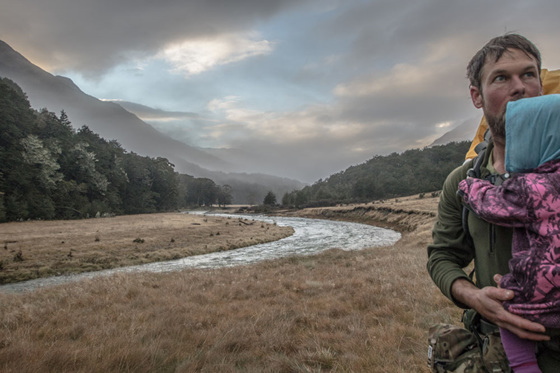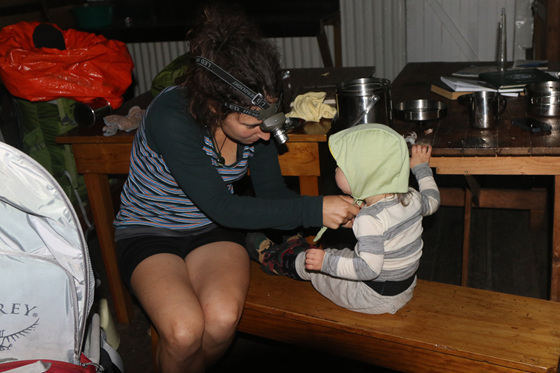Although there’s no reason to stop hiking just because the days are shorter, and the weather is colder, much more caution and care needs to be taken if you’ve got little people with you.
Check out the huts before you go.
In winter, we always check online whether or not the hut we’re going to has a fireplace. And preferably, that’s also when we go to the newer insulated huts too, as even with a fire on, it can get pretty chilly in the older huts!
Before you go to sleep, make sure you’ve also got enough kindling and wood to re-light the fire during the night if need be.
Take a shelter.
A tarp that’s lightweight, with eyelets, but durable enough to use as a groundsheet too works best. Seriously, unless we’re taking a tent – and even sometime if we are – we will still take one of these with us in spring and autumn as well as in winter. They make a great groundsheet when you can’t find a dry place to sit for lunch or a break. You can also use it as a cover for a rest when it’s raining, as little tummies still need a food break regardless of the weather. We’ve been super thankful for the tarp on so many occasions!

Check the weather.
This should go without saying any season of the year, but is super important in winter. If there is a storm coming, just re-schedule or cancel your trip. You don’t want to be caught out with rising rivers or heavy snow with a little one. (Or even just yourself really!) But you’ll have to be extra conservative if planning on taking a small child.
Plan shorter walks.
In winter, if we’re doing an overnight or longer hike, we tend to try stick to 4 hours sign-posted time per day maximum. If it’s a day walk with good weather we will sometimes do up to 7 hours signposted time, but given the weather can change so quickly we try not to go too far each day on overnight / multi-day tramps in winter. That means we’re not too long out in the cold, or caught in rain trying to keep a non-walking child warm!
Layer, layer, layer.
For a baby under 6 months old that’s still on your front, they probably only really need one or two extra layers compared to you. I’d also only use wool, as fleece and other non-natural fibres can’t breathe, so the baby can overheat as they can’t regulate their body temperature well yet. If it’s windy or raining, just put your raincoat over both of you – a larger size raincoat should be fine for a smaller baby, or invest in a babywearing soft-shell jacket. Because the baby is right up on your chest, you’ll be able to feel how warm they are at all times. Just make sure their breathing area is clear of any obstructions, and don’t forget to keep an eye on fingers and toes.
For kids older than 6 months, make sure you have a raincover for your hiking pack. And even though I’m a fan of natural fibres, fleece is definitely superior in keeping you warmer on the trails. I tend to use wool thermals on the bottom, with polyprop & fleece on top. And if it’s windy or raining, a raincoat and a pair of waterproof pants.
For kids younger than about 2.5, gumboots are the perfect footwear, as they’re 100% waterproof, and your under 2.5 year old is unlikely to be walking large distances yet, so comfort doesn’t matter too much yet. Just make sure they’ve got thick wool socks, or two pairs of thin ones. Fleece gumboot liners are also a good idea.
We also love our daughters fleece onesie. It means no cold hips or backs, and so is great not only for sleep, but for hiking in also.
I also find that bonnets are the best hats, as you just tie them under the neck, and they can’t come off. Buffs are great too as they also don’t come off as easily, and can be worn a million ways!
For keeping fingers warm, wool socks make great gloves for little hands. For older kids you can use ski gloves, and tying them to each other with longer string is a great way to not lose a pair!
If pottying your child, split crotch pants are super handy. They’re pretty much a pair of pants with a hole in the crotch area, and a big overlap to keep them decent. It saves taking pants off when potting to keep bums warm, or you can even change nappies through the hole too!
Once they are walking decent distances, proper kids hiking boots really are the way to go. Plus, remember all the normal rules that apply to adults too – no cotton, no denim, etc.
And very importantly, don’t rely on your toddlers answer when you ask if they’re cold!
Take some dessert to cook.
This might seem like an unnecessary one, and it is a bit optional, but having some warm desert in the long dark winters evening after a day out in the cold is amazing. Some of our faves are semolina with dark chocolate, or self-saucing chocolate pudding made as dumplings.
Besides – you need more calories when hiking!

FMC thanks Sonia Barrish for her permission to reproduce this article, first published on her Back to the Wild blog. Sonia makes and sells a range of home-made ointments, rubs and products such as insect repellent which are non-toxic and baby friendly.
This resource is part of FMC’s Outdoor Community campaign, celebrating and encouraging Family Tramping. Check out the other articles on Family Tramping here on Wilderlife. If you’ve got stories, tips or encouragement that you’re willing to share, please get in touch.









